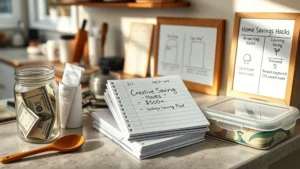Let’s cut right to the chase: setting up a simple budget for young adults isn’t about complicated spreadsheets or sacrificing all your fun. It’s about taking control—knowing where your money goes, making room for the essentials, and yes, even treating yourself now and then without that nagging guilt. If you’re wondering how to start this whole budgeting thing without feeling overwhelmed, you’re in the right place.
So, what’s the simplest way to get your finances in check? First, track what you earn and spend, then prioritize essentials like rent or groceries, and finally, set up a small savings habit that sticks. It sounds basic… because it is. But that’s what makes it powerful. Let’s dive into this and figure out how you can build a budget that feels more like a helpful friend than a strict drill sergeant.
Why Budgeting Matters
Benefits You’ll Actually Feel
Think of budgeting like giving your money a little GPS. Instead of wondering where your paycheck disappears each month, budgeting shows you exactly where your cash is heading. This clarity is a game-changer.
Short-term, a budget helps you pay bills on time—it’s a huge stress-reducer when you avoid nasty late fees or overdraft charges. Long-term? You’re setting yourself up to build an emergency fund that cushions life’s surprises and slowly grow your savings or investments. It’s like planting seeds for your future freedom.
What To Watch Out For
But hey, budgeting isn’t about turning into a money monk. If you get too strict, it can backfire—think burnout and sneaky impulse splurges. The trick is balance. Don’t treat your budget like a prison sentence; instead, make it flexible to grow with your life, and don’t ignore those random expenses that pop up out of nowhere.
The Trusted Take
This is not just friendly advice. Government financial agencies and consumer experts highlight how a importance of budgeting for young adults lies in reducing financial stress and moving toward independence—as early as you can start, the better.
Core Components Of A Simple Budget
Step 1: Know Your Income
Yep, the first golden rule is knowing exactly how much money is coming in. Include wages, side gigs, even that occasional birthday cash. If your earnings vary (hello, gig economy), look back at your past few months’ income to guess an average.
Step 2: Identify Your Expenses
Expenses fall into two camps: fixed and variable. Fixed expenses are the usual suspects—rent, utilities, phone bills. Variable, on the other hand, includes groceries, gas, and yes, that Friday night pizza or Netflix subscription.
Try grouping these into essentials (needs), extras (wants), and savings/debt. This will help you see where the money should flow and where you might trim.
Step 3: Prioritize Using The 50/30/20 Rule
You might have heard whispers about the 50/30/20 budgeting rule—it’s a neat, simple guideline that breaks down your after-tax income into 50% for needs, 30% for wants, and 20% for savings or debt repayment. It’s flexible, too. For example, if rents are crazy high where you live, you might shift the percentages a bit.
Alternatively, if zero-based budgeting feels more your style, you assign every dollar a specific job, ensuring your income minus spending equals zero. It’s like a financial puzzle, helping you mindfully direct cash rather than letting it surprise you.
Step 4: Pay Yourself First
Sounds fancy, but it’s simple: prioritize your savings. Set aside even a small amount, like $25 a week, before you spend a dime on fun stuff. That grows into an emergency fund that could cover three to six months’ living expenses—your safety net on bad days. Also, if you have debt, plan how much you can chip away monthly to lighten the load faster.
10 Financial Tips For Young Adults
1. Track Every Penny For A Month
It might sound tedious, but jotting down where you spend money—even that morning coffee—makes you suddenly more aware. Awareness brings control.
2. Automate Savings
Set up automatic transfers to your savings account. It’s easier to forget it’s there and not miss what you don’t see.
3. Autopay Your Bills
This helps avoid late fees and keeps your credit score happy—a win-win.
4. Pick One Budget Method and Stick To It
Don’t jump around. Pick the approach that feels doable and keep at it. Your budget should support you, not stress you.
5. Audit Subscriptions Quarterly
Ever heard of “subscription creep”? Those little monthly fees add up. Cut what you don’t use.
6. Build a Mini Emergency Fund First
A couple hundred bucks saved gives peace of mind. Think of it as your financial cushion.
7. Start Retirement Savings Early
It’s never too early to contribute, even in small amounts. Time is the magic ingredient for growth.
8. Avoid Lifestyle Inflation
After a raise or bonus, it’s tempting to upgrade your lifestyle immediately. Resist, and funnel some of that money into savings.
9. Use Discounts and Low-Fee Banking Options
Students and young adults qualify for deals. Explore them—it pays off.
10. Review And Adjust Your Budget Monthly
Life changes, so should your budget. Keep it flexible, and don’t beat yourself up if you slip a bit.
Sample Budget For Young Adults: Real Life Examples
Student Or Part-Time Worker
| Category | Monthly Budget |
|---|---|
| Income (part-time + allowance) | $800 |
| Rent (shared housing) | $300 |
| Groceries | $150 |
| Transportation | $50 |
| Phone & Internet | $60 |
| Entertainment | $70 |
| Savings | $170 |
Entry-Level Salary (~$35,000/year)
| Category | Monthly Budget |
|---|---|
| Take-home income | $2,300 |
| Rent | $700 |
| Utilities & Internet | $120 |
| Groceries | $250 |
| Transportation | $150 |
| Dining Out/Entertainment | $300 |
| Debt repayment | $300 |
| Savings | $480 |
Variable Income / Gig Worker
Average your last 3 months, set a baseline for essentials, then buffer a little extra monthly into a “rainy day” fund. Pay yourself first whenever you get paid.
Budgeting Tools For Young Adults
Apps
Apps like Mint, YNAB (You Need A Budget), or Spendee can automate expense tracking and help you visualize where your money flows. This makes budgeting less of a headache and more of a daily habit.
Worksheets & Planners
Classic and effective. The Financial Consumer Agency of Canada offers a great budgeting tools for young adults that you can customize and print. Sometimes simply writing it down gives you a clear, hands-on connection with your finances.
Picking The Right Tool
Think about what fits your style. Are you tech-savvy and love automation? Go for apps. Prefer tangible, offline tracking? Grab a worksheet or budget planner. Either way, the best tool is one you actually use.
How To Stay On Track
Regular Check-Ins
Set a mini ritual—maybe Sunday evenings or paydays—to glance at your budget. What’s burning a hole in your wallet? Are savings growing? These simple check-ins build good habits and reduce surprises.
Plan For Those Big Expenses
Have annual payments or holiday travel? Break down these costs monthly via sinking funds—small chunks you stash away regularly so you’re not scrambling later.
Keep Your Budget Real
We all face FOMO and social pressures. Talk openly with roommates or friends about goals and affordable ways to hang out. Budgeting doesn’t mean isolating yourself; it means choosing what truly matters to you.
When To Seek Expert Help
Beyond DIY Budgeting
If your debt feels like a monster, your income is irregular, or you’re hitting major life changes (hello, first apartment or new job!), it might be worth chatting with a trusted financial counselor or expert. Knowing when to ask for help is a financial win in itself.
Trustworthy Sources Matter
Stick with advice from government agencies, certified professionals, and nonprofit organizations. This way, you avoid scams or confusing info that can derail your progress—keeping your journey honest and safe.
Wrapping It Up
Alright, let’s recap: a simple budget for young adults isn’t about perfection—it’s about starting where you are. Begin by tracking your income and expenses, separating needs from wants, and making space to save a little, no matter how small. Remember the 50/30/20 rule as a helpful guide, but don’t be afraid to tweak it to fit your life.
Keep these 10 financial tips handy, check in weekly, and use tools that feel good for you, whether that’s an app or a paper planner. And hey, don’t forget to be kind to yourself—budgets grow and flex just like we do.
So, what’s your next step? Maybe take 10 minutes today to jot down your last paycheck and all the little things you bought. That’s the start of your budgeting journey.
Budgeting is your tool to financial freedom, and trust me—it’s more rewarding than it sounds. Want to learn more about the importance of budgeting for young adults or discover cool budgeting tools for young adults? You’re already on the right track by reading this.













